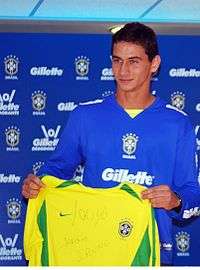Fluminense FC
Fluminense Football Club (Brazilian Portuguese: [flumiˈnẽsi ˈfutʃibow klɐb]), known simply as Fluminense or Tricolor, is a Brazilian sports club best known for its professional football team plays in the Campeonato Brasileiro Série A,[nb 1] the first tier of Brazilian football and the Campeonato Carioca,[nb 2] the state league of Rio de Janeiro. The club is based in the Laranjeiras neighbourhood of Rio de Janeiro. Fluminense plays their home games at the Maracanã Stadium, which currently holds up to 78,838 spectators.
 | |||
| Full name | Fluminense Football Club | ||
|---|---|---|---|
| Nickname(s) | Tricolor, Flu, Fluzão (Big Flu), Nense, Pó de Arroz (Rice Powder), Time de Guerreiros (Team of Warriors) | ||
| Founded | 21 July 1902 | ||
| Stadium | Maracanã Stadium Rio de Janeiro, Brazil | ||
| Capacity | 78,639[1] | ||
| President | Mário Bittencourt | ||
| Current coach | Odair Hellmann | ||
| League | Campeonato Brasileiro Série A Campeonato Carioca | ||
| 2019 2019 | Série A, 14th Cariocão, 4th | ||
| Website | Club website | ||
|
| |||
The club was founded on 21 July 1902 by the sons of Carioca aristocrats, being led by Oscar Cox, a Brazilian sportsman, in the bairro of Flamengo, a direct contrast between the aristocratic founders and the modest ground it was founded on. Cox was elected as the club's first president. Fluminense have been state champions on 31 occasions, second only to Flamengo with 34. The team have been national champions four times, most recently in 2012 in Campeonato Brasileiro Série A, they won the Copa do Brasil in 2007 and the Campeonato Brasileiro Série C [nb 3], the third tier of Brazilian football in 1999. The Copa Rio de 1952(or Copa Rio Internacional) and the Copa Libertadores runners up in 2008 and the Copa Sudamericana runners up in 2009 are their best international performances.
Fluminense is a demonym for people who reside in the State of Rio de Janeiro. Although football was the club's original endeavor, the club is today an umbrella organisation for several teams in more than 16 different sport activities.
Fluminense's traditional home kit is dark red-and-green vertical striped shirts, with white shorts, accompanied by white socks; this combination has been used since 1920. Under Armour is the current kit manufacturer. It holds several long-standing rivalries with other clubs, most notably with Flamengo (this rivalry is popularly known as Fla-Flu), as well as with Botafogo and Vasco da Gama.
The club has contributed the fifth-most players to Brazil's national football team.[2]
History
Fluminense Football Club was founded on 21 July 1902 in Rio de Janeiro by Oscar Cox, a Brazilian of English heritage,[3] in the then aristocratic neighbourhood of Laranjeiras.[4] Fluminense was formed by sons of the elite who had come into contact with football while studying in Europe.[5]

The first official match was played against now defunct Rio FC, and Fluminense won 8–0.[3] The club's first title came in 1906, when Fluminense won the Campeonato Carioca.[3]
In 1911, disagreement between Fluminense players led to the formation of Flamengo's football team.[3] The so-called Fla-Flu derby is considered one of the biggest in the history of Brazilian football.[6] Three years later, in Fluminense's stadium, the Brazilian national football team debuted, against touring English club Exeter City.[3] It was also there that they won their first title, in 1919.[7]
By 1922, Fluminense had 4,000 members, a stadium for 25,000 people, and facilities that impressed clubs in Europe.[8]

In an unfortunate event in 1914, Carlos Alberto, a mulatto playing for Fluminense, decided to cover himself in face powder to disguise the color of his skin. This ultimately led to one of the club's nicknames, pó de arroz, which is the Portuguese for 'white powder'.[9][10] Although, like almost all football teams in Brazil at the time, racism was common among Fluminense supporters, Fluminense had a long history of black players even before football became a professional sport.[11] [12] [13]
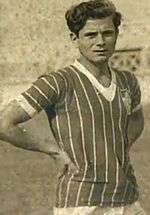
The following years saw an expansion of the club's hegemony in Rio. Fluminense would remain unsurpassed in terms of state championships until 2009.[14] International acclaim came in 1949 with the awarding of the Olympic Cup, and was further fostered in 1952 with Fluminense's World-wide honour, the Copa Rio. The club established itself regionally with victory in two Torneio Rio-São Paulo cups in 1957 and 1960.[3] National honors followed in 1970, 1984, 2010 and 2012 with Taça de Prata and Série A cups, respectively,[3] also taking the Cup in Brazil in 2007 and the Brasileirão Série C in 1999.
From the 1950s, with the creation of the Rio-São Paulo Tournament, the forerunner of what eventually would become the national championship, Fluminense established itself regionally by winning the tournament title in the years of 1957 and 1960.
From the 1960s, the first national championships began to be played in Brazil. Fluminense's first national title came in 1970; at that time, Brazil had the best players in world football, and all of them played in Brazilian clubs. Although its squad was not counted among the main contenders of the season in Brazil, Fluminense won the Brazilian championship and surpassed the great strengths of the time in Santos, Palmeiras and Cruzeiro.
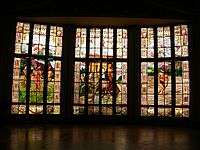
In the 1970s, Fluminense signed several famous players like Roberto Rivellino. This time, called "maquina tricolor", they won the state championship in the years of 1975 and 1976. In the national championship, Fluminense lost in the semifinal matches to Internacional in 1975 and Corinthians in 1976.
Fluminense again became Brazilian champions in 1984. This time, they won the state Championship in the years of 1983, 1984 and 1985 with players like Romerito, Ricardo Gomes, Deley, and the "Casal Vinte": Assis and Washington.
At the end of the 1980s, Copa do Brasil was created, inspired by the Cup tournaments played in European countries. Fluminense reached the final of the Copa do Brasil for the first time in 1992, but lost to Internacional de Porto Alegre.
A disastrous campaign led to the club's relegation from Brasileirão Série A in 1996. A set of off-field political manoeuvres, however, not performed by Fluminense, allowed Fluminense to remain in Brazil's top domestic league,[15] only to be relegated the next year.[16] Completely out of control the club was relegated from Série B to Série C in 1998.[17] In 1999, Fluminense won the Série C championship and were to be promoted to Série B when they were invited to take part in Copa João Havelange,[18] a championship that replaced the traditional Série A in 2000. In 2001, it was decided that all clubs which took part in Copa João Havelange's so-called Blue Group should be kept in Série A.[19]
In 2002, 2005 and 2012, Fluminense won the Campeonato Carioca again. In 2005 Fluminense reached the final of the Copa do Brasil again, but lost to Paulista Futebol Clube.
In 2007, Fluminense won the Copa do Brasil, after beating Figueirense in the final, and was admitted to the Copa Libertadores again after 23 years.[3][20] The club's campaign saw them reach the final and included remarkable matches against Arsenal de Sarandí, São Paulo and Boca Juniors.[21][22][23] Fluminense lost the final to LDU Quito in a penalty shootout.[24]
After signing 27 players and going through 5 different managers in 2009, Fluminense found themselves struggling to avoid another relegation from Série A.[25] With less than one-third of the championship left, the mathematical probability of the club's relegation was 98%.[26] At this point, manager Cuca decided to dispense with some of the more experienced players and gave Fluminense's youngsters a chance.[27] That, along with Fred's recovery from a serious injury and substantial support from the fans, allowed not only a sensational escape from relegation, but also placed Fluminense in the final of the Copa Sudamericana.[28][29] For the second year in a row, the club contested a continental cup. In a repeat of the previous year's Copa Libertadores, Fluminense lost the final to LDU Quito.[30]

In 2010, Fluminense won the Brazilian championship for the third time in their history, marking their third national championship after 1970 and 1984. It was also the fourth title for coach Muricy Ramalho in a decade: Ramalho had won the title three times in a row with São Paulo from 2006 to 2008. Darío Conca was named the Brazilian Championship's Player of the Season, while Fred and Washington were decisive players in Fluminense's winning campaign.
On 23 May 2012, Fluminense lost the semifinal qualification match to Boca Juniors from Argentina, for the continental club football cup, Copa Libertadores.[31] Later that year, on 11 November, they won their fourth Brazilian championship after defeating the near-relegated Palmeiras 3–2.[32] Fluminense won the Série A for the fourth time on 11 November 2012.[33]
In December 2013, a draw with Bahia in the last round of the 2013 Campeonato Brasileiro Série A had Fluminense mathematically relegated to Série B. However, irregular lineups by Portuguesa and Fluminense's main rivals Flamengo in their matches against Grêmio and Cruzeiro respectively caused both teams to lose 4 points after a trial in STJD (Brazil's governing football jury). That allowed Fluminense to stay in Série A, with Portuguesa being relegated instead and Flamengo ending the championship as the last non-relegated club.
Performance



Fluminense have taken part in 47 of the 49 official Serie A championships organized in Brazil since 1971.[34]
| Year | Position | Participants | Year | Position | Participants |
|---|---|---|---|---|---|
| 1971 | 16 | 20 | 1981 | 11 | 44 |
| 1972 | 14 | 26 | 1982 | 5 | 44 |
| 1973 | 23 | 40 | 1983 | 18 | 44 |
| 1974 | 24 | 40 | 1984 | 1 | 41 |
| 1975 | 3 | 42 | 1985 | 22 | 44 |
| 1976 | 4 | 54 | 1986 | 6 | 48 |
| 1977 | 26 | 62 | 1987 | 7 | 16 |
| 1978 | 22 | 74 | 1988 | 3 | 24 |
| 1979 | 52 | 94 | 1989 | 15 | 22 |
| 1980 | 11 | 44 | 1990 | 15 | 20 |
| Year | Position | Participants | Year | Position | Participants |
|---|---|---|---|---|---|
| 1991 | 4 | 20 | 2001 | 3 | 28 |
| 1992 | 14 | 20 | 2002 | 4 | 26 |
| 1993 | 28 | 32 | 2003 | 19 | 24 |
| 1994 | 15 | 24 | 2004 | 9 | 24 |
| 1995 | 4 | 24 | 2005 | 5 | 22 |
| 1996 | 23 | 24 | 2006 | 15 | 20 |
| 1997 | 25 | 26 | 2007 | 4 | 20 |
| 1998 | Série B | 2008 | 14 | 20 | |
| 1999 | Série C | 2009 | 16 | 20 | |
| 2000 | 3 | 25 | 2010 | 1 | 20 |
| Year | Position | Participants | Year | Position | Participants |
|---|---|---|---|---|---|
| 2011 | 3 | 20 | |||
| 2012 | 1 | 20 | |||
| 2013 | 15 | 20 | |||
| 2014 | 6 | 20 | |||
| 2015 | 13 | 20 | |||
| 2016 | 13 | 20 | |||
| 2017 | 14 | 20 |
Records
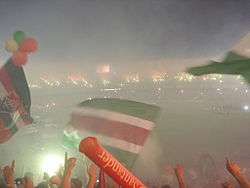

Highest attendances – Maracanã[35]
- 1. Fluminense 0–0 Flamengo, 1963 194,603 ¹
- 2. Fluminense 3–2 Flamengo, 1969 171,599
- 3. Fluminense 1–0 Botafogo, 1971 160,000
- 4. Fluminense 0–0 Flamengo, 1976 155,116
- 5. Fluminense 1–0 Flamengo, 1984 153,520
- 6. Fluminense 1–1 Corinthians, 1976 146,043
¹: 177,656 paying, a record for persons present at Maracanã stadium.
Highest average attendance at public competition for Fluminense
- Largest average attendance in the Copa Libertadores (RJ): 52,801 (49,011 paying, 2008)
- Largest average attendance in the Copa Sudamericana (RJ): 29,357 (27,318 paying, 2009)
- Largest average attendance in international tournaments (RJ): 48,797 (37,541 paying, Copa Rio, 1952)
- Largest average attendance in national championships (RJ): 43,541 paying (1976)
- Largest average attendance in the Tournament Roberto Gomes Pedrosa (RJ): 40,408 paying (1970)
- Largest average attendance in the Brazil Cup (RJ): 27,123 paying (2007)
- Largest average attendance in the Rio-São Paulo Tournament (RJ): 33,018 paying (1960)
- Largest average attendance in the state championship: 47,814 paying (1969, all stages)
- Largest average attendance in the state championship in the Maracana Stadium: 93,560 paying (1969, 10 matches)
Support

The supporters of Fluminense Football Club are usually related to the upper classes of Rio de Janeiro.[36] However, the popularity of the club reaches beyond the city limits. Recent polls have estimated the number of supporters to be between 1.3% and 3.7% of the Brazilian population.[37] Considering a population of 185 million people,[38] that would account for numbers between 2.73 and 6.84 million.
The best attendance ever observed in a match of Fluminense was registered on 15 December 1963 in a rally against Flamengo. On that day, an impressive number of 194,000 people showed up at Maracanã stadium.[39] This occasion remains as the stadium's record for a match between clubs.[40]
Notable supporters of Fluminense include composers Cartola and Chico Buarque,[41][42] FIFA president of honor João Havelange,[6] musician Ivan Lins,[43] poet and actor Mário Lago,[44] journalist and songwriter Nelson Motta,[45] dramatist, journalist and writer Nelson Rodrigues,[45] 1970 FIFA World Cup winner Gérson, Paris Saint-Germain central defender Thiago Silva, Left-back legend Marcelo, former Minister of Culture Gilberto Gil, Silvio Santos, the owner of SBT, the second largest Brazilian television network,[46] and the Academy Award nominee Fernanda Montenegro.[47]
Main Titles
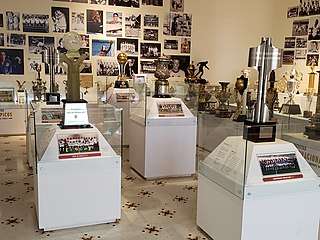
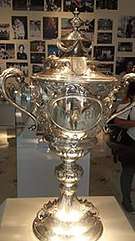
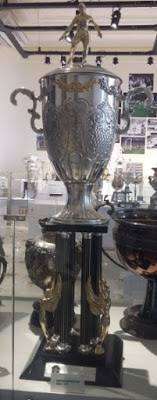
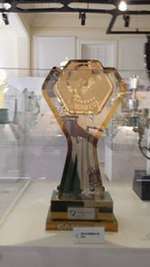
Honours
- Olympic Cup: 1949
- Carioca Champion of the 20th Century: 1906-2000
Worldwide
- Copa Rio Internacional: 1952
International
- Tournoi de Paris: 1976, 1987
- Teresa Herrera Trophy: 1977
- Kirin Cup: 1987
- Kiev Tournament: 1989
- Seul Tournament: 1984
- Viña del Mar Tournament: 1976
- International Summer Tournament of Rio de Janeiro: 1973
National
Regional
- Torneio Rio-São Paulo: 1957, 1960
- Taça Ioduran – Rio-São Paulo: 1919
Fluminense main derbies
- Fla-Flu, also called Derby of Crowds ('Clássico das Multidões'),[48] played with Flamengo;
- Giants' Derby ('Clássico dos Gigantes'); played with Vasco da Gama;
- Grandpa Derby ('Clássico Vovô'), played with Botafogo. The name comes from being the two oldest practicing football clubs among the great clubs of Rio de Janeiro, and this is also the oldest classic in Brazil, because its first game was on October 22, 1905, friendly that the Fluminense won by 6–0.
According to the fluzao.info site, the average paying public at the principal classics of Fluminense played in the Estádio do Maracanã is 60,107 against Flamengo, 43,735 against Vasco, 34,359 against Botafogo, 25,127 against America and 22,527 against Bangu (1950-2010). These statistics could be about 20% higher, given the issues of the distribution of gratuities at Maracanã.[49]
Corinthians vs Fluminense, interstate derby
The derby against Corinthians is perhaps the most representative among the various confrontations with big Brazilian clubs played by Fluminense, given the fact that these clubs often intersect at decisive moments in their seasons.[50]
Statistics
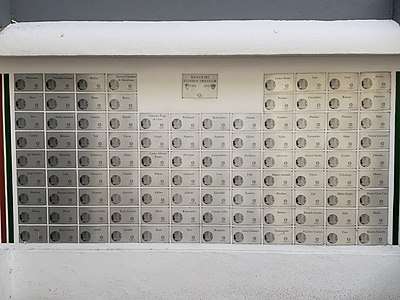
- Records.[51]
Players with most appearances
| Name | Matches | |
|---|---|---|
| 1st | 699 | |
| 2nd | 603 | |
| 3rd | 556 | |
| 4th | 549 | |
| 5th | 490 | |
| 6th | 462 | |
| 7th | 433 | |
| 8th | 424 | |
| 9th | 403 | |
| 10th | 397 | |
Top goalscorers

| Name | Goals | Years | |
|---|---|---|---|
| 1st | 319 | 1954–61 | |
| 2nd | 188 | 1945–55 | |
| 3rd | 172 | 2009–16 | |
| 4th | 165 | 1935–42 | |
| 5th | 164 | 1950–61 | |
| 6th | 163 | 1913–23 | |
| 7th | 149 | 1933–44 | |
| 8th | 128 | 1925–39 | |
| 9th | 124 | 1983–89 | |
| 10th | 121 | 1998–2002 / 2015-2016 | |
Coaches with most games
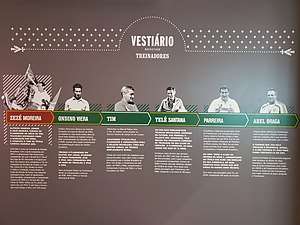
| Name | Matches | |
|---|---|---|
| 1st | 467 | |
| 2nd | 300 | |
| 3rd | 202 | |
| 4th | 178 | |
| 5th | 166 | |
| 6th | 156 | |
| 7th | 146 | |
| 8th | 138 | |
| 9th | 137 | |
| 10th | 126 | |
Sponsors
Companies that Fluminense Football Club currently has sponsorship deals with include:
Players
Current squad
- As of 31 May 2020[52]
Note: Flags indicate national team as defined under FIFA eligibility rules. Players may hold more than one non-FIFA nationality.
|
|
Reserve team
Note: Flags indicate national team as defined under FIFA eligibility rules. Players may hold more than one non-FIFA nationality.
|
|
Out on loan
Note: Flags indicate national team as defined under FIFA eligibility rules. Players may hold more than one non-FIFA nationality.
|
|
First-team staff
- As of 29 June 2020
| Position | Name | Nationality |
|---|---|---|
| Head coach | Odair Hellmann | |
| Assistant coaches | Edevaldo de Freitas | |
| Daniel Cerqueira | ||
| Marcão | ||
| Technical assistant | Marco Salgado | |
| Fitness coaches | Marcos Seixas | |
| Marcelo Chirol | ||
| Gabriel Pinho | ||
| Goalkeeper coaches | André Carvalho | |
| João Carlos Gonçalves | ||
Head coaches
|
|
|
See also
Notes
- Also known by its nickname Brasileirão.
- Also known by its nickname Cariocão.
- Also known by its nickname Terceirona.
References
- http://secure.rio2016.com/maracana/o-novo-estadio-do-maracana-tera-capacidade-para-78639-espectadores%5B%5D
- RSSSF Brasil - Jogadores cedidos por clube na história da Seleção Brasileira (in Portuguese) - Retrieved 15 September 2018
- "Fluminense – Forever Flu". Fédération Internationale de Football Association (FIFA). Retrieved 7 June 2009.
- "Fluminense fiesta". BBC Sport. British Broadcasting Corporation (BBC). 22 August 2002. Retrieved 11 June 2009.
- "How football conquered Brazil". 18 May 2009. Retrieved 11 June 2009.
- "Passion, carnival and crazy goals". Fédération Internationale de Football Association (FIFA). 13 July 2001. Retrieved 10 June 2009.
- "Southamerican Championship 1919". Rec. Sport. Soccer Statistics Foundation (RSSSF). Retrieved 11 June 2009.
- Mason, Tony (1995). Passion of the people? Football in South America. Verso. p. 54. ISBN 978-0-86091-403-7. Retrieved 10 June 2009.
- Rodrigues, Mário (2003). O negro no futebol brasileiro (in Portuguese). Mauad. pp. 36, 37, 41, 44, 51, 60, 62, 63, 69, 70, 77, 210, 281. ISBN 978-85-7478-096-2. Retrieved 13 June 2009.
- "Pó-de-arroz: provocação que virou símbolo". globoesporte.com (in Portuguese). 5 March 2008. Retrieved 13 June 2009.
- "No Dia da Consciência Negra, Fluminense põe os "pingos nos is" e desmistifica rótulos racistas". explosaotricolor.com (in Portuguese). 5 November 2015. Retrieved 13 April 2016.
- "Fluminense desmistifica origem do apelido "Pó de arroz"" (in Portuguese). netflu. 13 May 2015. Retrieved 13 April 2016.
- "A mentira que ganhou ares verdadeiros, agora cai por terra". canelada (in Portuguese). 14 May 2015. Archived from the original on 17 May 2015. Retrieved 13 April 2016.
- "Fla consolida supremacia com seis títulos na década". Jornal O Dia (in Portuguese). 4 May 2009. Archived from the original on 6 July 2011. Retrieved 11 June 2009.
- "Santos and sinners". When Saturday Comes (WSC). February 2003. Archived from the original on 4 November 2011. Retrieved 12 June 2009.
- "Brazil 1997 Championship". Rec. Sport. Soccer Statistics Foundation (RSSSF). Retrieved 4 December 2009.
- "Brazil 1998 Championship - Second Level (Série B)". Rec. Sport. Soccer Statistics Foundation (RSSSF). Retrieved 4 December 2009.
- "Brazil 1999 Third Level (Série C)". Rec. Sport. Soccer Statistics Foundation (RSSSF). Retrieved 4 December 2009.
- "Brazil 2001 Championship". Rec. Sport. Soccer Statistics Foundation (RSSSF). Retrieved 4 December 2009.
- "Fluminense volta à Libertadores após 23 anos". UOL Esporte (in Portuguese). 6 June 2007. Retrieved 12 June 2009.
- "Flu massacra Arsenal em noite de gala". globoesporte.com (in Portuguese). 5 March 2008. Retrieved 12 June 2009.
- "Flu leva a melhor no Maraca e está na semifinal da Taça Libertadores". globoesporte.com (in Portuguese). 21 May 2008. Retrieved 12 June 2009.
- Leach, Conrad (6 June 2008). "Flu flay Boca as Brazilians fly into final". The Guardian. London. Retrieved 12 June 2009.
- Duarte, Fernando (4 July 2008). "Fluminense in mourning after Maracana party turns to tears". The Guardian. London. Retrieved 12 June 2009.
- "Balcão de negócios e alta rotatividade ajudam a explicar desespero do Flu". globoesporte.com (in Portuguese). 5 October 2009. Retrieved 14 December 2009.
- "Degola mais próxima: Fluminense tem 98% de chances de rebaixamento". globoesporte.com (in Portuguese). 9 October 2009. Retrieved 14 December 2009.
- "Por xeque-mate contra queda, Cuca celebra troca de peças no Tricolor". globoesporte.com (in Portuguese). 4 November 2009. Retrieved 14 December 2009.
- "Fred saves the day for Flu". Fédération Internationale de Football Association (FIFA). Retrieved 15 December 2009.
- "A média de público final do Campeonato Brasileiro 2009". O Globo (in Portuguese). Rio de Janeiro. 8 December 2009. Retrieved 14 December 2009.
- "Fluminense luta até o fim, mas título fica novamente com a LDU, verdadeiro algoz". globoesporte.com (in Portuguese). 3 December 2009. Retrieved 14 December 2009.
- "Fluminense está eliminado da Libertadores". Bagarai.com (in Portuguese). Retrieved 23 May 2012.
- Danilo Lavieri, Danilo; Rodrigues, Renan (11 November 2012). "Fluminense vence com gols de Fred, vira tetra brasileiro e deixa Palmeiras a um jogo da queda". UOL Esportes (in Portuguese). Presidente Prudente. Retrieved 11 November 2012.
- "Fluminense crowned champions". Goal.com. 12 November 2012. Retrieved 18 December 2012.
- "RECORDS OF FLUMINENSE IN MAJOR COMPETITIONS" (in Portuguese). Rec. Sport. Soccer Statistics Foundation (RSSSF). Retrieved 11 June 2009.
- "OS MAIORES PÚBLICOS DO FLUMINENSE FOOTBALL CLUB NA HISTÓRIA (ACIMA DE 90.000):". Retrieved 21 July 2015.
- "Perfil dos torcedores do Rio". Jornal O Globo (in Portuguese). Retrieved 7 June 2009.
- "Brazilian Clubs with Most Fans". RSSSF Brazil. Retrieved 10 July 2009.
- "Contagem da População 2007" (PDF) (in Portuguese). Instituto Brasileiro de Geografia e Estatística (IBGE). 21 December 2007. Archived from the original (PDF) on 6 February 2009. Retrieved 10 June 2009.
- "Best attendances in matches of Fluminense". Rec. Sport. Soccer Statistics Foundation (RSSSF). Retrieved 12 June 2009.
- "Best Attendances in Brazil" (in Portuguese). Rec. Sport. Soccer Statistics Foundation (RSSSF). Retrieved 12 June 2009.
- "Brasil está em débito com Cartola". O Estado de S. Paulo (in Portuguese). 27 December 2000. Retrieved 12 June 2009.
- Hunt, Jemima (18 July 2004). "The lionised king of Rio". The Guardian. London. Retrieved 10 June 2009.
- "Tricolor Skylab se desespera com show na mesma hora da final em Quito". globoesporte.com (in Portuguese). 25 June 2008. Retrieved 12 June 2009.
- "MST e Fluminense presentes na última homenagem a Mário Lago". Jornal do Brasil Online (in Portuguese). 31 May 2002. Retrieved 12 June 2009.
- Motta, Nelson; Gueiros, Pedro (2004). Fluminense: a breve e gloriosa história de uma máquina de jogar bola (in Portuguese). Rio de Janeiro: Geração Editorial. pp. 1–9. ISBN 978-85-00-01574-8. Retrieved 10 June 2009.
- "Fluminense homenageia grandes torcedores". Terra (in Portuguese). 17 December 2001. Retrieved 2 January 2012.
- "Fernanda Montenegro leva os netos ao Engenhão". Extra (in Portuguese). 11 December 2010. Retrieved 2 January 2012.
- Livro “Fla-Flu... E as Multidões Despertaram”, de Nélson Rodrigues e Mário Filho (Edição Europa, 1987).
- "Estatísticas Fluminense". Retrieved 21 July 2015.
- GloboEsporte.com (10 July 2012). "Corinthians é visto como o maior rival no futebol nacional, diz pesquisa (apontando as principais rivalidades para cada clube, não a importância dos clássicos)". GloboEsporte.com. Retrieved 15 June 2017.
- Lance! newspaper - Em meio à críticas e quase barração, Gum chega a 350 jogos pelo Tricolor - in portuguese.
- "Elenco". Fluminense's official professional roster. Retrieved 2 February 2018.
External links
| Wikimedia Commons has media related to Fluminense Football Club. |
| Look up Fluminense in Wiktionary, the free dictionary. |
- Official website (in Portuguese)
- Flickr: Fluminense Oficial's Photostream – Downloadable Fluminense Photos (in English)
- Fluminense Football Club News at Sambafoot.com (in English)
- Fluminense F.C. Page at Goal.com (in English)
- Fluminense F.C. Fan Page at Soccerway (in English)
- Statistics on major competitions (in Portuguese)
- Statistics on all matches between 1902 and 2006 (in Portuguese)
- NETFLU – Hourly News about Fluminense Football Club (in Portuguese)
- Statistics on the 2009 Série A championship (in Portuguese)
- Fluminense F.C. daily news in Portuguese (in Portuguese)
- Official Fluminense Football Club page at FIFA (in English)
- Fluminense Football Club Page at ESPN Global (in English)
- Fluminense F.C. at The World Game: News, Results & Tables (in English)
